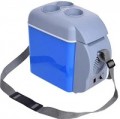Type
—
Refrigerator container. Thermally insulated containers designed for use in cars and as close as possible to ordinary kitchen refrigerators both in functionality and appearance. They look like boxes, most often plastic, can have a rather large volume (40 liters or more), are designed primarily for stationary installation in a car and are usually quite inconvenient to carry (although most models can be easily carried in hands over short distances). Equipped with temperature maintenance systems (up to compressors, see "Functions"), they require external power supply.
—
Cooler bag. Like the containers described above, this type belongs to car accessories, requires external power, is able to provide cooling similar to classic refrigerators, and can also have other modes of operation (see below). Externally, in accordance with the name, such models resemble ordinary bags, often have fabric upholstery, external pockets, and almost always carry handles. They are easy to transport in your hands, which can be useful for loading: it is often more convenient to load the refrigerator in the kitchen and transfer it to the car than to carry the products separately to the car. This design of the refrigerator is also especially convenient for outdoor trips, picnics, etc. On the other hand, bags usually have a small volume (not exceeding 40 liters).
— Embedded. As the name implies, this variety is desig
...ned for permanent installation in vehicles. Its main difference from the containers-refrigerators described above is its poor suitability for carrying from place to place, in addition, such devices can have quite large volumes. Due to their large size, most built-in refrigerators are not well suited for passenger cars, where there is usually little space — but they can be very useful for buses, tractors, motorhomes, and even boats and yachts. Some of these models are originally made for a specific brand of car.
— Refrigerator-armrest. A specific type of refrigerator-containers (see the relevant paragraph). The main difference of this variety from the "ordinary" containers is just the possibility of installation as an armrest. At the same time, installation methods can be different: some models are placed in the centre of the rear seat and are fixed with a seat belt, others can also be installed between the front seats. The main advantage of such units can be called the fact that they create a minimum of discomfort, and often vice versa — they provide additional convenience, playing the role of the actual armrest. In addition, coasters and other additional devices can be provided on the case. However, before buying, you should make sure that the selected model is suitable for your car in shape and dimensions. Also note that the volume of refrigerators of this type is relatively small — usually less than 25 liters.Volume
The volume of the working chamber of the car refrigerator. The larger the volume, the more products can be loaded into the unit at a time. When choosing according to this parameter, it makes sense to select a model with a margin, because it is not recommended to load products too tightly — this adversely affects the quality of the device. On the other hand, note that the volumetric container and dimensions will have the appropriate ones.
Number of chambers
The presence in the refrigerator of separate zones for storing products, separated by a stationary dense wall of a non-removable structure. The vast majority of car refrigerators have a
single-chamber layout, however, there are also
two-chamber models, which is extremely convenient for sorting products.
Max. heating at
An indicator of how many degrees the refrigerator is able to heat the product placed in it relative to the ambient temperature (if there is a heating function). Suppose a product at a temperature of +15 °C is placed in a refrigerator with a maximum heating of 60 °C; thus, the temperature of the product at the end of heating will be 75 °C, which is more than enough for the perception of food as warm and its comfortable consumption.
Сooling energy consumption
The power consumed by the refrigerator when operating in cooling mode. The greater this power, the more performant the refrigerator is, usually, and the less time it takes to cool the product. On the other hand, note that more power means more power consumption — which can be critical, for example, during long-term operation from a car battery (that is, when the car engine is turned off).
Heating energy consumption
The power consumed by the refrigerator when operating in heating mode. As with cooling, more power usually means more performance; see "'Сooling energy consumption" for details.

